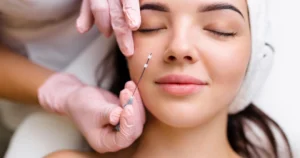Introduction
Dysport® has emerged as a popular option for those seeking to reduce the appearance of facial wrinkles in aesthetic treatments. As a neurotoxin similar to Botox, Dysport® offers a nonsurgical approach to rejuvenation. This comprehensive guide will explore what Dysport® is, how it works, and what patients can expect from Dysport® injections. Whether you’re considering this treatment for the first time or simply want to learn more, this article will provide you with the essential information you need.
What is Dysport®?
Definition and Origins
Dysport® is a brand name for botulinum toxin type A, a neurotoxin produced by the bacterium Clostridium botulinum. It was first developed in the United Kingdom in the 1990s and used for various medical and cosmetic purposes. In 2009, the U.S. Food and Drug Administration (FDA) approved Dysport® for cosmetic facial wrinkles treatment.
How Dysport® Differs from Other Neurotoxins
While Dysport® is similar to other botulinum toxin products like Botox, there are some key differences:
- Molecular structure: Dysport® has a slightly different molecular structure, which can affect how it spreads in the tissue.
- Onset of action: Some patients report that Dysport® takes effect more quickly than other neurotoxins.
- Diffusion: Dysport® may have a broader area of effect, which may be helpful when treating larger areas, but requires a precise injection technique.
How Does Dysport® Work?
The Science Behind Dysport®
Dysport® usage relies on temporarily blocking nerve signals to specific muscles. Here’s a breakdown of the process:
- Injection: A healthcare professional injects Dysport® into targeted facial muscles.
- Nerve signal blockage: The neurotoxin inhibits the release of acetylcholine, a neurotransmitter that controls muscle contractions.
- Muscle relaxation: Reduced nerve signals cause the targeted muscles to relax, smoothing the overlying skin.
- Wrinkle reduction: As the muscles relax, the appearance of wrinkles and fine lines diminishes.
Areas Commonly Treated with Dysport®
Dysport® is FDA-approved for treating moderate to severe frown lines between the eyebrows, known as glabellar lines. However, it’s also used off-label for other areas, including:
- Forehead lines
- Crow’s feet around the eyes
- Bunny lines on the nose
- Chin dimpling
- Neck bands
The Dysport® Treatment Process
Consultation and Preparation
Before receiving Dysport® injections, patients should:
- Consult a qualified provider
- Discuss medical history, including any allergies or neuromuscular disorders
- Before treatment, avoid blood-thinning medications and supplements
- Cleanse the face thoroughly on the day of treatment
The Injection Procedure
The Dysport® injection process is relatively quick and straightforward:
- The provider will clean and mark the injection sites
- A very fine needle is used to inject Dysport® into the targeted muscles
- The entire procedure typically takes 10-20 minutes
- Anesthesia is usually not required, but patients may experience mild discomfort
Post-Treatment Care and Recovery
After receiving Dysport® injections, patients should:
- Avoid rubbing or massaging the treated area for 4 hours
- Stay upright for 4 hours after treatment
- Avoid strenuous exercise for 24 hours
- Apply cold compresses if there’s any swelling or bruising
Results and Expectations
Timeline of Effects
Patients can expect the following timeline:
- Initial effects: Some patients report seeing results within 24-48 hours
- Full effect: The maximum effect is typically reached within 7-14 days
- Duration: Results usually last 3-4 months, but this can vary among individuals
Factors Affecting Dysport® Results
Dysport® treatments can be affected by several factors:
- Individual metabolism
- Age and skin condition
- Injection technique and dosage
- Muscle strength and usage patterns
Safety and Side Effects
Common Side Effects
While Dysport® is generally safe when administered properly, some patients may experience mild side effects including:
- Temporary redness or swelling at the injection site
- Mild headache
- Slight bruising
- Temporary eyelid drooping (in rare cases)
Precautions and Contraindications
Dysport® may not be suitable for everyone. It’s important to avoid Dysport® if you:
- Are allergic to any ingredients in Dysport®
- Infection at the site of the planned injection
- Are pregnant or breastfeeding
- Have certain neuromuscular disorders
Choosing a Provider for Dysport® Treatments
Qualifications to Look For
When selecting a provider for Dysport® injections, consider the following:
- Board certification in dermatology, plastic surgery, or a related field
- Specific training and experience with Dysport® injections
- Before-and-after photos of previous patients
- Positive patient reviews and testimonials
Questions to Ask Your Provider
During your consultation, don’t hesitate to ask:
- How many Dysport® treatments have you performed?
- What results can I realistically expect?
- Are there alternative treatments I should consider?
- How do you achieve natural-looking results?
Conclusion
Dysport® offers a practical, non-surgical option for reducing the appearance of facial wrinkles. Temporarily relaxing specific muscles can help patients achieve a more youthful, refreshed appearance. Although the treatment is generally safe and well-tolerated, choosing a qualified provider and carefully following all pre- and post-treatment instructions are crucial.
If you’re considering Dysport® injections, we invite you to schedule a consultation with our experienced team at Sheperd Integrative Dermatology. Our providers can assess your needs and develop a personalized treatment plan to help you safely and effectively achieve your aesthetic goals. Contact us today to learn how Dysport® can help you look and feel your best.





